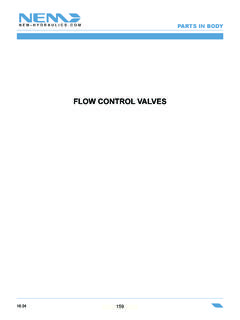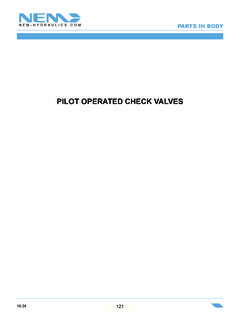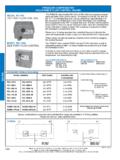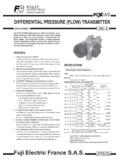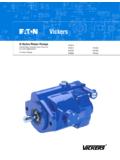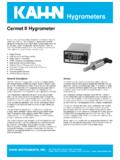Transcription of COUNTERBALANCE VALVES - NEM
1 CARTRIDGESCOUNTERBALANCE COUNTERBALANCE VALVES are hydraulic VALVES designed specifically to hold and control negative or gravitational loads. They are meant to serve all those applications that involve the control of suspended loads, such as mechanical joints, lifting applications, extensible movable bridge, winches, VALVES main functionalities are lowering velocity control and stationary load holding. COUNTERBALANCE VALVES hydraulic symbol is similar to an integrated micro-circuit, in which 3 characteristic components can be identified: A uni-directional valve, which allow a free feeding to the hydraulic actuator and lock load in the required position.
2 A pressure relief valve, which, thanks to its specific configuration, holds the loads acting on hydraulic actuators (for instance, cylinders or motors) and limits max pressurization, allowing also stress control, where needed. A pilot piston, which opens the pressure relief valve, thanks to connection to hydraulic energy source. Example of COUNTERBALANCE valve applicationGenerally, COUNTERBALANCE VALVES are installed directly on cylinders or hydraulic actuators (ex. Port A1-1). COUNTERBALANCE VALVES (A, 2)(X, 3)(A1,1)A1B1AA1B1 ABA1 AXA1B1 APTBBHYDRAULIC guarantees load control and holding even in case of rupture or external leakage of the hoses connecting valve and setting device (directional control valve).
3 Picture nr. 2 shows an example of truck crane hydraulic scheme, which is a typical application for COUNTERBALANCE VALVES . WORKING PRINCIPLET hanks to the uni-directional VALVES , oil flow regulated by the directional control valve comes inside the cylinder facing minimum resistance. When directional spools are in neutral position, sealing devices are in rest position, locking connection between hydraulic actuator and directional control valve. Thanks to mechanical sealing obtained through grinded sealing point, it s possible to avoid leakage through the spools of uni-directional valve.
4 COUNTERBALANCE VALVES , in fact, are able to close with very small leakage (<10 drops/min). Since there are no dents nor saturation effects (possible even in case of clean oil), a perfect sealing will take place in a few Connection to pilot line (X-3) consequence of directional spool change-over determines the progressive opening of the COUNTERBALANCE VALVES , up to the balance satisfying the flows continuity equation. That guarantees the absence of cavitations and also the control of dragged loads lowering VALVES setting corresponds to the opening pressure of pressure relief section.
5 This pressure determines the max load which COUNTERBALANCE valve is able to hold. Usually the setting pressure value must be at least times the max load induced pressure to hold. That tolerance allows induced loads safe holding. setting pressure (Pt) of COUNTERBALANCE VALVES corresponds to pressure on port (1), while the valve is crossed by a 4l/min flow (picture 3). es. Pt: 350 bar @ 4 l/min In particular cases, and generally upon customers request, the pressure can be set considering the initial opening value, corresponding almost to 20 ml/min.
6 Flow. es. Pt: 350 bar @ 20 ml/min 24 lpm13 COUNTERBALANCE VALVESHYDRAULIC RATIOAs mentioned before, COUNTERBALANCE VALVES are characterized by a pilot area on which pressure coming from the actuator s feeding line acts. Such pressure , together with the pressure due to the load, moves pilot piston, progressively contrasting the force generated by the setting the combined action of the two pressures is connected to the ratio between the pushing areas on which they act. This ratio is known as Pilot Ratio (pr), and it is the basic parameter for any COUNTERBALANCE Ratio (pr) is defined as the geometrical ratio between the area on which the load acts (port 1) and the pilot area (port 3).
7 Thanks to this parameter, it is possible to calculate the values of pilot pressures first opening (Px):Px = (Pt P1) / rpAccording the Pilot Ratio, COUNTERBALANCE VALVES can be divided in 2 types:High Pilot Ratio (>6:1): suitable for those applications where the loads are constant (for instance, hydraulic motors) and very stable, where low pilot pressures are demanded in favour of speed and energy savings. Low Pilot Ratio (<5:1): suitable for those applications where loads can vary (for instance, trucks cranes) and for those mechanical structures are not stable, where more control and more stability are needed, an higher pilot pressure is COUNTERBALANCE VALVES are installed on hydraulic actuators, to determine the correct value of pilot pressure it is necessary to introduce in the calculation the ratio between the areas of the actuator = (Pt P1) / (rp+ra)ra.
8 Ratio between the areas of the hydraulic actuator ra = area fondello / area anulare (X)3(A)2(A1)1(A)2(A1)1(X)3(A)2(A1)1(X)3( A)2(A1)1(X)3ra = 1ra= cap area/annular areaCOUNTERBALANCE VALVESHYDRAULIC CARTRIDGESPo (Setting)P1 (Load)PX*rp (Pilot) of coupling COUNTERBALANCE VALVES with directional control VALVES , considering the type of spool to use is needed. When the COUNTERBALANCE VALVES are in charge of the pressure relief function, it s essential to make a distinction between closed-centre spool applications and open-centre spool , when closed-centre spools are installed, it s necessary to use compensated COUNTERBALANCE VALVES : since these VALVES are insensitive to back- pressure on return line (A-2), their pressure setting won t change.
9 Two examples of compensated VALVES application are regenerative circuits and circuits in which draining of eventual pressure peaks must be relieved in series by the anti-shock VALVES installed inside the directional control case of open-centre directional spool application, not- compensated VALVES are compulsory, in which the spring is connected to the return line (A-2).In Not- compensated (N) type VALVES , back- pressure affects both pressure setting and pilot pressureIn these VALVES , the return line is directly connected to the spring.
10 VALVES in which adjustable spring isconnected to return line are not compensated ones. Main use: open-centre spool Fully- compensated (C) type VALVES , back- pressure does not affect neither pressure setting nor pilot pressure . Belong to this type the VALVES in which the adjustable spring is separated from return line (A-2) and is connected to a draining line or is these VALVES , back- pressure (A-2) is balanced, so it won t find any area to carry out its force, so that both setting and pilot pressures are independent from pressure on return line (A).

